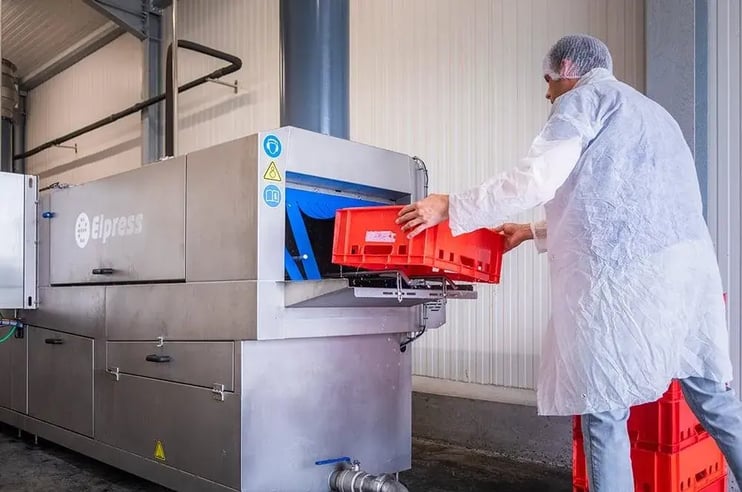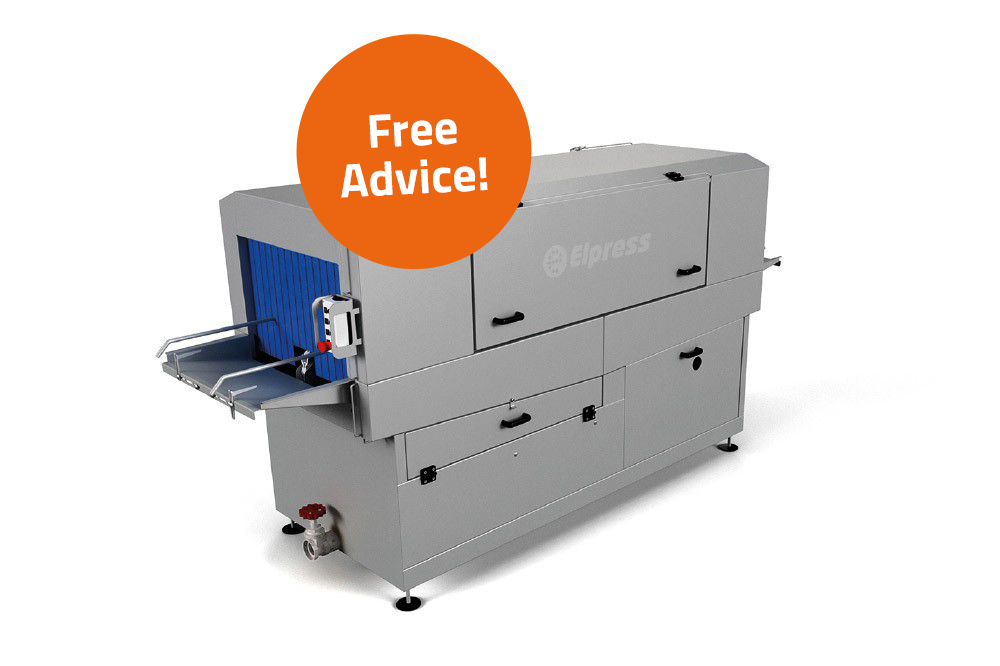Visual inspection of washed crates

Those who work in the food industry know how critical good hygiene is. Personal hygiene demands attention – but equipment and crates also have to be spotlessly clean. To make the work of quality employees a bit easier, Elpress is introducing another innovation: a ‘visual inspection’ of your washed crates.
Crate washer improves food safety
A crate washer is an essential item for food-processing companies. Food is often transported in crates; with or without packaging. In the case of unpackaged food, this mostly involves internal transport, while packaged food is associated with external transport. The crates from both workflows have to be thoroughly cleaned for the simple reason that you won’t be complying with hygiene regulations if you don’t. Dirt, bacteria as well as stickers and glue residues attach themselves very easily to crates. You can wash these crates by hand, but that takes time and the output is not always constant. That’s why Elpress builds systems that automatically and thoroughly clean 1,500 to 2,000 crates per hour per line as standard. Automatic destacking, blow drying and restacking are also possible. Some customers in the food industry have double versions of a crate washer with a throughput of up to 4,000 crates per hour.
But: who checks whether the crates are actually clean when they leave the machine, each and every day? Elpress introduces a new self-learning system that does this for you automatically.
Visual inspection of your crates by the Crate Inspection System
After the cleaned crates come out of the washer, it is a good idea to regularly check whether they really are clean. Dirty or damaged crates can lead to problems with food safety. In many companies, this check is done by an employee. Elpress has developed a system that can carry out this step: the Crate Inspection System. This involves visually checking all five of the internal sides of a crate after the washing process. The system can tell within just one second whether the crate is clean as well as intact. Crates with dirt residues or damage are ejected from the line by a pusher. The system is also suitable for high numbers of crates per hour. So you can be sure that you are complying with the hygiene guidelines as well as saving time and money.
Self-learning system offers certainty
How does the system know when a crate is clean? Firstly, it must be clear what is meant by ‘clean’ and what is not. By feeding the system with photos of dirty crates, it is able to build up a database, allowing it to learn the desired definition of clean and dirty itself over time. The same applies to broken crates. This process gets better and better the more crates that pass through it. A self-learning system, in other words. If a crate is dirty or defective, a pusher ejects the crate from the line so that it can take a different route. Of course, you can also opt to stop the line if a crate is dirty or broken: the choice is entirely yours. If there a too many dirty crates, you can adjust the washing process. For example, by modifying the parameters of the crate washer to ensure the washing result is right. This process can also be automated: the system adjusts itself whenever necessary.
Advantages of a smart crate inspection
With the new Crate Inspection System, companies in the food-processing industry like yours get a controlled system that lets you ensure you always work with clean crates. What’s more, fewer people need to stand at the machine to check the crates – a bonus in an increasingly tight labour market. The visual inspection also works much more accurately than a person’s eyes and also lets you print out and share the results. Handy for audits and new customers who want to see how you ensure hygiene standards. And it’s easier for you to get quality certificates such as ISO 22000. To summarise:
- You always work with clean crates: that element of the hygienic working progress is guaranteed;
- Fewer staff are needed for the washing process of crates, saving you time and money;
- More accurate inspection: a dirty or broken crate is identified more quickly;
- Tangible results for audits and new customers;
- Helps you to get the ISO 22000 certificate.
Crate washer calculator: which crate washer suits your needs?
Before we talk to you about the possible purchase of a crate washer, you can use our handy crate washer calculator to easily determine which crate washer suits your business. You will then receive a first tailor-made advice that Elpress will be happy to elaborate further with you during a subsequent meeting. Start the calculator and receive free advice within 1 minute.
- Which crate washer suits your needs
- Additional information about the recommended crate washer
- How many crates you can maximum wash with this variant
- Additional information about the different washing zones
- Additional information on selecting the optimal crate washer.
Complete the crate washer calculator and find out which crate washer fits your situation perfectly:
.webp)



.jpg?width=600&height=300&name=eCIS-(4).jpg)
.jpg?width=600&height=300&name=eCIS-(2).jpg)